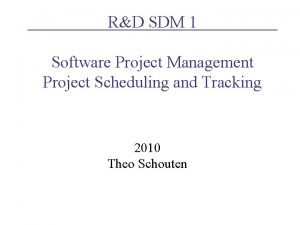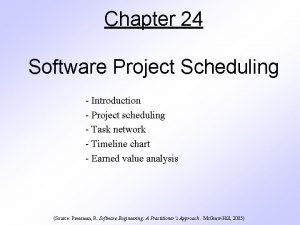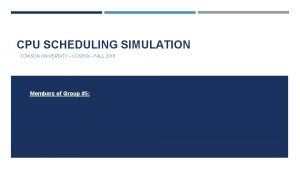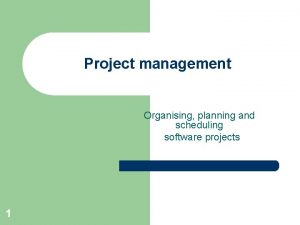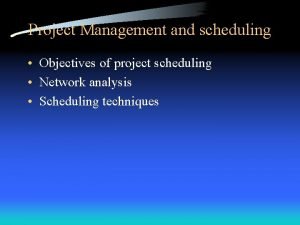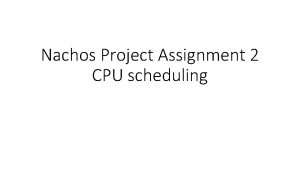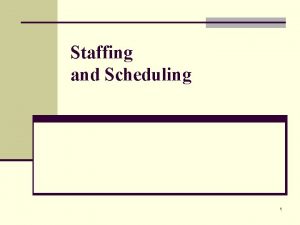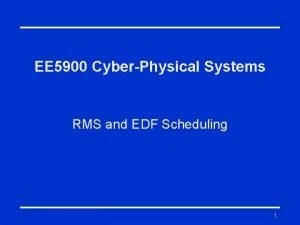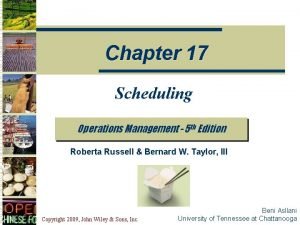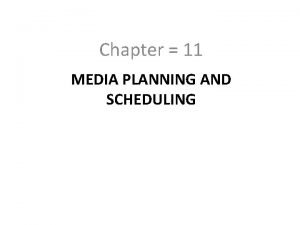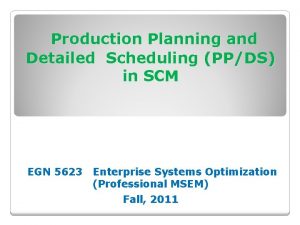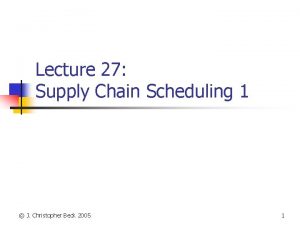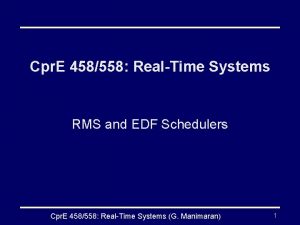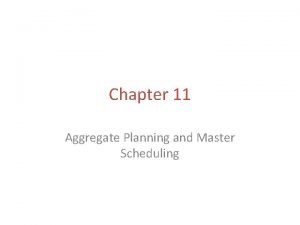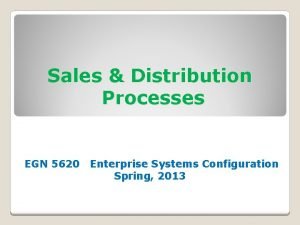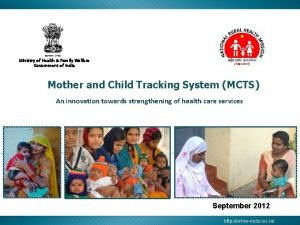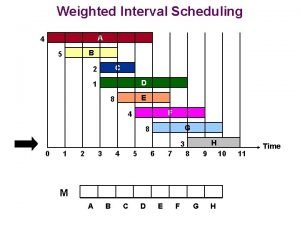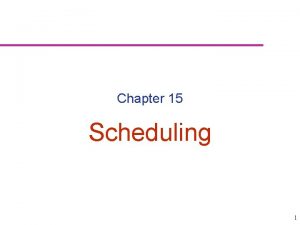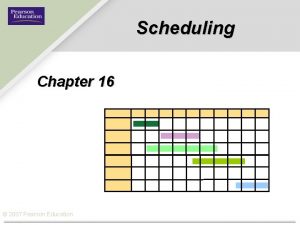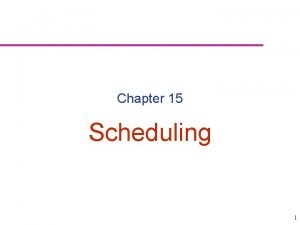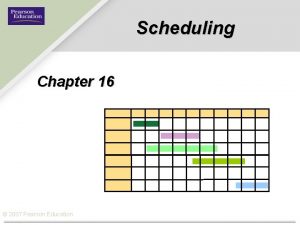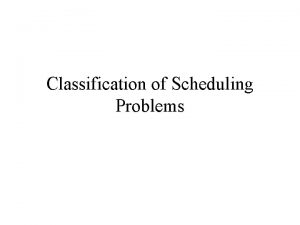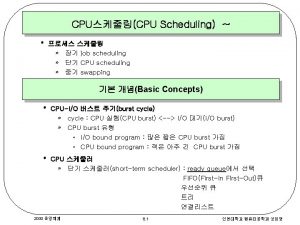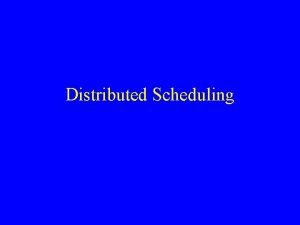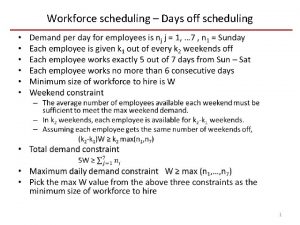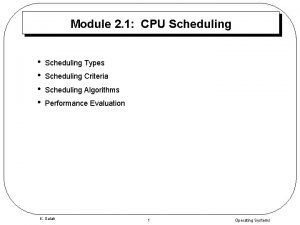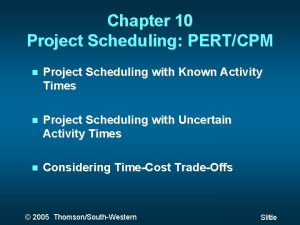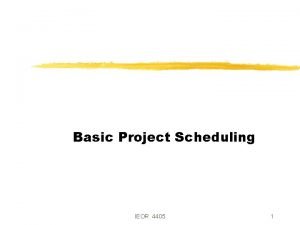Chapter 7 Project Scheduling and Tracking 1 Project








































- Slides: 40

Chapter 7 Project Scheduling and Tracking 1

Project Scheduling Includes Task Sets Concept Development Project Tracking Involves Distributes effort across duration of project Allocates effort to tasks – man hours/man months 2

Scheduling Project Manager's Task - schedule project 1. Define all project tasks 2. Build a network depicting dependencies 3. Identify the critical tasks 4. Track progress enduring delays recognized 5. React 3

Effort Distribution Requirements Specification – 40% Coding - 20% Testing an Validation -40% 4

Why Are Projects Late? an unrealistic deadline established by someone outside the software development group changing customer requirements that are not reflected in schedule changes; an honest underestimate of the amount of effort and/or the number of resources that will be required to do the job; predictable and/or unpredictable risks that were not considered when the project commenced; 5

Why Are Projects Late? technical difficulties that could not have been foreseen in advance; human difficulties that could not have been foreseen in advance; miscommunication among project staff that results in delays; a failure by project management to recognize that the project is falling behind schedule and a lack of action to correct the problem 6

Scheduling Principles compartmentalization—define distinct tasks interdependency—indicate task interrelationships, effort validation—be sure resources are available defined responsibilities—people must be assigned defined outcomes—each task must have an output defined milestones—review for quality 7

Defining Task Sets determine type of project 1. Concept Development 2. New Application 3. Application Enhancement 4. Application Maintenance 5. Reengineering 8

Defining Task Sets assess the degree of rigor required identify adaptation criteria compute task set selector (TSS) value interpret TSS to determine degree of rigor select appropriate software engineering tasks 9

Example I. 2 Pre lim ina ry c o nc ep t p la nning I. 3 Tec hno log y risk a sse ssm e nt Pla nning Enginee ring / Construc tio n Projec t Definitio n I. 1 Co nc e p t sc op ing I. 4 Pro o f of c o nc e p t Conc ept Development Ree nginee ring Applica tion Maintenance New Applica tion Developme nt Enha ncement I. 6 Custo me r re a c tion Custo m er Eva lua tion I. 5 Co nc e p t imp le me nta tion Relea se Figure 7. 2 Concept development tasks using an evolutionary model. 10

Define a Task Network 11

Effort Allocation 40 -50% 15 -20% “front end” activities customer communication analysis design review and modification construction activities coding or code generation testing and installation 30 -40% unit, integration white-box, black box regression 12

Use Automated Tools to Derive a Timeline Chart 13

Pert, CPM, and Gantt Taken from "A Professional's Guide to Systems Analysis", Martin E. Modell, 2 nd. Ed. Mc. Graw Hill, 1996. Previous Steps Before attempting to use these tools, the project's information must be assembled properly. The project planning process and resulting Perts, CPM, and Gantts consists of the following: 14

Pert, CPM, and Gantt 1. Setting the project start date 2. Setting the project completion date 3. Selecting the project methodology or project life cycle to be used 4. Determining the scope of the project in terms of the phases of the selected project methodology or project life cycle 5. Identifying or selecting the project review methods to be used 15

Pert, CPM, and Gantt 6. Identifying any predetermined interim milestone or other critical dates which must be met. 7. Listing tasks, by project phase, in the order in which they might be accomplished. 8. Estimating the personnel necessary to accomplish each task 9. Estimating the personnel available to accomplish each task 10. Determining skill level necessary to perform each task 11. Which tasks can be done in parallel 12. Which tasks require the completion of other tasks before they can start 16

Pert, CPM, and Gantt Project control or review points Performing project cost estimation and costbenefit analysis Construct a WBS Work Breakdown Structure 17

Pert, CPM, and Gantt Work breakdown Structures The development of a project plan is predicated on having a clear and detailed understanding of : the tasks involved, the estimated length of time each task will take, the dependencies between those tasks, and the sequence tasks have to be performed. 18

Pert, CPM, and Gantt A definition Awork breakdown structure(WBS) is a hierarchic decomposition or breakdown of a project or major activity into successive levels, with each level a finer breakdown of the preceding one. In final form a WBS is very similar in structure and layout to a document outline. Each item at a specific level of a WBS is numbered consecutively (e. g. , 10, 30, 40, 50 ). Each item at the next level is numbered within the number of its parent item (e. g. , 10. 1, 10. 2, 10. 3, 10. 4). 19

Pert, CPM, and Gantt The WBS may be drawn in a diagrammatic form (if automated tools are available) or in a chart resembling an outline. The WBS begins with a single overall task representing the totality of work to be performed This becomes the name of the project plan WBS. Using a process model (methodology) or SDLC software development life cycle (analysis, design and implementation) steps as a guide, the project is divided into its major steps or phases. 20

Pert, CPM, and Gantt The Phases first phase is project initiation; the second major phase is analysis, followed by design, construction, testing, implementation, and post-implementation follow-up. Each of these phases must be broken in their next level of detail, and each of those, into still finer levels of detail, until a manageable task size is arrived at. 21

Pert, CPM, and Gantt The first WBS level for the life cycle would be: WBS number Task Description Project initiation Draft project plan Analysis phase Plan user interviews Schedule users interviews Examination and test Design Test Implementation Postimplementation review 1. 0 1. 1 2. 0 2. 1 2. 2 3. 0 4. 0 5. 0 6. 0 7. 0 22

Pert, CPM, and Gantt Tasks at each successively finer level of detail are numbered to reflect the task from which they were derived. Thus, the first level of tasks would be numbered 1. 0, 2. 0, 3. 0, and so forth. Each of their subtasks would have a two part number: the first part reflecting the parent task and the second part, the subtask number itslef, such as 1. 1, 1. 2, or 1. 3. As each of these, in turn, decomposed or broken down into its component tasks, each component receives a number comprised of it's parent number plus a unique number of its own. 23

Pert, CPM, and Gantt A definition A manageable task is one in which the: expected results can be easily identified; success, failure, or completion of the task can be easily ascertained; the time to complete the task can be easily estimated; and resource requirements of the task can be easily determined. 24

Pert, CPM, and Gantt Program Evaluation and Review Technique (PERT) PERT charts depict task, duration, and dependency. Each chart starts with an initiation node from which the first task, or tasks, originates. If multiple tasks begin at the same time, they are all started from the node or branch, or fork out from the starting point. 25

Pert, CPM, and Gantt Each task is represented by a line which states its name or other identifier, its duration, the number of people assigned to it, and in some cases the initials of the personnel assigned. T The other end of the task line is terminated by another node which identifies the start of another task, or the beginning of any slack time, that is, waiting time between tasks. 26

Pert, CPM, and Gantt Each task is connected to its successor tasks in this manner forming a network of nodes and connecting lines. The chart is complete when all final tasks come together at the completion node. When slack time exists between the end of one task and the start of another, the usual method is to draw a broken or dotted line between the end of the first task and the start of the next dependent task. 27

Pert, CPM, and Gantt A PERT chart may have multiple parallel or interconnecting networks of tasks. If the scheduled project has milestones, checkpoints, or review points (all of which are highly recommended in any project schedule), the PERT chart will note that all tasks up to that point terminate at the review node. 28

Pert, CPM, and Gantt It should be noted at this point that the project review, approvals, user reviews, and so forth all take time. This time should never be underestimated when drawing up the project plan. It is not unusual for a review to take 1 or 2 weeks. Obtaining management and user approvals may take even longer. 29

Pert, CPM, and Gantt When drawing up the plan, be sure to include tasks for documentation writing, documentation editing, project report writing and editing, and report reproduction. These tasks are usually time-consuming, so don't underestimate how long it will take to complete them. 30

Pert, CPM, and Gantt PERT charts are usually drawn on ruled paper with the horizontal axis indicating time period divisions in days, weeks, months, …. While it is possible to draw a PERT chart for an entire project, the usual practice is to break the plans into smaller, parts. This is very helpful if the chart has to be redrawn for any reason, such as skipped or incorrectly estimated tasks. Many PERT charts terminate at the major review points, such as at the end of the analysis. 31

Pert, CPM, and Gantt Many organizations include funding reviews in the projects life cycle. Where this is the case, each chart terminates in the funding review node. Funding reviews can affect a project in that they may either increase funding, in which case more people have to made available, or they may decrease funding, in which case fewer people may be available. Obviously more or less people will affect the length of time it takes to complete the project. 32

Pert, CPM, and Gantt Critical Path Method (CPM) charts are similar to PERT charts and are sometimes known as PERT/CPM. In a CPM chart, the critical path is indicated. A critical path consists that set of dependent tasks (each dependent on the preceding one) which together take the longest time to complete. 33

Pert, CPM, and Gantt Although it is not normally done, a CPM chart can define multiple, equally critical paths. Tasks which fall on the critical path should be noted in some way, so that they may be given special attention. One way is to draw critical path tasks with a double line instead of a single line. 34

Pert, CPM, and Gantt Tasks which fall on the critical path should receive special attention by both the project manager and the personnel assigned to them. The critical path for any given method may shift as the project progresses; this can happen when tasks are completed either behind or ahead of schedule, causing other tasks which may still be on schedule to fall on the new critical path. 35

Pert, CPM, and Gantt GANTT Charts A Gantt chart is a matrix which lists on the vertical axis all the tasks to be performed. headed by columns indicating estimated task duration, skill level needed to perform the task, and the name of the person assigned to the task, followed by one column for each period in the project's duration. 36

Pert, CPM, and Gantt GANTT Charts Each period may be expressed in hours, days, weeks, months, and other time units. In some cases it may be necessary to label the period columns as period 1, period 2, and so on. 37

Pert, CPM, and Gantt The graphics portion of the Gantt chart consists of a horizontal bar for each task connecting the period start and period ending columns. A set of markers is usually used to indicate estimated and actual start and end. Each bar on a separate line, and the name of each person assigned to the task is on a separate line. 38

Pert, CPM, and Gantt In many cases when this type of project plan is used, a blank row is left between tasks. When the project is under way, this row is used to indicate progress, indicated by a second bar which starts in the period column when the task is actually started and continues until the task is actually completed. Comparison between estimated start and end actual start and end should indicate project status on a task-by-task basis. 39

Pert, CPM, and Gantt Variants of this method include a lower chart which shows personnel allocations on a personby-person basis. For this section the vertical axis contains the number of people assigned to the project, and the columns indicating task duration are left blank, as is the column indicating person assigned. The graphics consists of the same bar notation as in the upper chart indicates that the person is working on a task. The value of this lower chart is evident when it shows slack time for the project personnel, that is, times when they are not actually working on any project. 40
 Project scheduling and tracking in software engineering
Project scheduling and tracking in software engineering Project scheduling and tracking
Project scheduling and tracking What is project scheduling in software engineering
What is project scheduling in software engineering Project scheduling and tracking software quality assurance
Project scheduling and tracking software quality assurance Job scheduling vs process scheduling
Job scheduling vs process scheduling Basic principles of project scheduling
Basic principles of project scheduling Identify critical path
Identify critical path Cpu scheduling project
Cpu scheduling project Scheduling project management
Scheduling project management Forward pass scheduling
Forward pass scheduling Cpu scheduling project
Cpu scheduling project Student tracking system project
Student tracking system project Production planning and inventory control
Production planning and inventory control Non preemptive scheduling
Non preemptive scheduling Staffing and scheduling
Staffing and scheduling Scheduling resources and costs
Scheduling resources and costs Difference between preemptive and nonpreemptive scheduling
Difference between preemptive and nonpreemptive scheduling Forward and backward scheduling
Forward and backward scheduling Rms and edf scheduling example
Rms and edf scheduling example Asap and alap scheduling example
Asap and alap scheduling example Loading in operations management
Loading in operations management Media scheduling strategies
Media scheduling strategies Principles of good routing and scheduling
Principles of good routing and scheduling Detailed scheduling
Detailed scheduling Carlsberg supply chain
Carlsberg supply chain Cdfg graph
Cdfg graph Rms and edf scheduling example
Rms and edf scheduling example Scheduling time-constrained projects focuses on resource
Scheduling time-constrained projects focuses on resource Advertising media planning and scheduling
Advertising media planning and scheduling Resource leveling
Resource leveling When the process issues an io request
When the process issues an io request Disaggregating the aggregate plan
Disaggregating the aggregate plan Forward and backward scheduling in sap sd
Forward and backward scheduling in sap sd Mother and child tracking system
Mother and child tracking system Family welfare services introduction
Family welfare services introduction Using assessment to drive instruction
Using assessment to drive instruction Simple online and realtime tracking
Simple online and realtime tracking Othman episode 1
Othman episode 1 Electromechanical breakdown in solid dielectrics
Electromechanical breakdown in solid dielectrics Treeing and tracking in solid dielectrics
Treeing and tracking in solid dielectrics Weighted interval scheduling
Weighted interval scheduling
